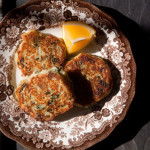Still on the Fence about Quinoa
Still on the fence about Quinoa? Perhaps this might change your mind..
Good news for Migraine Headache sufferers- If you are prone to migraines, try adding quinoa to your diet. Quinoa is a good source of magnesium, a mineral that helps relax blood vessels, preventing the constriction and rebound dilation characteristic of migraines. Increased intake of magnesium has been shown to be related to a reduced frequency of headache episodes reported by migraine sufferers. Quinoa is also a good source of riboflavin, which is necessary for proper energy production within cells. Riboflavin (also called vitamin B2) has been shown to help reduce the frequency of attacks in migraine sufferers, most likely by improving the energy metabolism within their brain and muscle cells.
Quinoa also supplies significant cardiovascular benefits for postmenopausal women. Women eating a serving of quinoa, or others considered in the grain family, at least 6 times each week is an especially good idea for postmenopausal women with high cholesterol, high blood pressure or other signs of cardiovascular disease (CVD). A 3-year prospective study of over 200 postmenopausal women with CVD, published in the July 2005 issue of the American Heart Journal, shows that those eating at least 6 servings of whole grains each week experienced both: Slowed progression of atherosclerosis, the build-up of plaque that narrows the vessels through which blood flows, and Less progression in stenosis, the narrowing of the diameter of arterial passageways. The women’s intake of fiber from fruits, vegetables and refined grains was not associated with a lessening in CVD progression. Antioxidant Protection Quinoa is a very good source of manganese and a good source of copper, two minerals that serve as co-factors for the superoxide dismutase enzyme. Superoxide dismutase is an antioxidant that helps to protect the mitochondria from oxidative damage created during energy production as well as guard other cells, such as red blood cells, from injury caused by free radicals. – An important side note for those who are on a gluten free diet-Quinoa is not actually a grain, rather it is a seed and therefore is not a gluten compadre as it is often categorized as.-read on-
A Grain or not a Grain
Quinoa is the subject of many a debate about its classification. I am asked about this a lot by my paleo, gluten free, and other clients with big concerns about whether or not they should eat it.
Here’s the skinny on Quinoa- It is not a grain! Quinoa is the seed of the Chenopodium or Goosefoot plant. It is frequently called a grain because it is used and cooked like one, and is often called an “Ancient Grain” and a “Wholegrain”. These terms can make it confusing, but trust me folks, it is not a grain.
Soak and rinse before you eat-
For those who find yourself sensitive to this power seed, I highly recommend soaking, then rinsing till water runs clear before you cook and eat quinoa. Unless of course, you buy the “pre-rinsed” version-which I still rinse. Quinoa has several industrial applications due to its high levels of bitter saponins. Found on the outside of the seeds, the saponins are cardiac glycosides (organic compounds that interfere with heart contractions) that must be processed from most varieties prior to consumption, usually by mechanically removing the pericarp (ovary wall) or by soaking in water. Those waste saponins can then be used to produce pharmaceuticals, such as synthetic steroids, and can be used in soaps, detergents, cosmetics, beer production, and fire extinguishers. The saponins also serve to repel birds and other creatures from eating the seeds before they can be harvested since the bitter taste is so offensive prior to treating it. If you are eating Quinoa and not soaking/rinsing it, even though it has been processed in a way that removes a god deal of the saponins, you can have side effects, many of which are similar to those experienced by those with a gluten intolerance. Symptoms can include but are not limited to gas, bloating, stomach upset, loose stools and so on. If you suffer from any of these or other gastro-intestinal disorders please consult your doctor before adding quinoa into your diet.
I truly hope this article perks your interest in this amazing seed. Perhaps a few recipes will help you along.
Quinoa Cakes
 Try these recipes on for size.
Try these recipes on for size.
As always, your comments are appreciated, questions always welcome at My Sage Gourmet where Wellness is Always in Season!
About Carol
Everything about My Sage Gourmet is intended to nurture and support you to thrive in every sense of the word. From the Kitchen Coaching, and my artisan kitchen blends to Nutrition Consulting, and the Tone and Sculpt Yoga and weight loss programs, My Sage Gourmet there to support you!
Carol is a Certified Nutrition Coach, Food and Fitness Blogger, Well Kitchen Coach, Cooking Instructor & Yoga Instructor. She partners with clients in reaching their wellness goals both in and out of the kitchen. She has developed a kitchen line of Herbed Salts that is from her garden to your table. Each of my five varieties is grown, picked, hand blended and made to order in small batches to guarantee the freshest, best tasting blends! You will taste the quality in every beautifully organic bite!
Carol provides wellness lectures, cooking demos and hands on cooking classes. She tests products, creates recipes around product lines that she believes you will enjoy. check out articles and recipes in print and via video at My Sage Gourmet.
She is known for her Kitchen Coaching, where she provides in-home classes to clean up and re-stock pantries, creating do-able, quick and healthy options for everyday use and special occasions.

